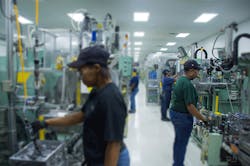7 Ways a Japanese Smart Factory in the South Represents the Future of Manufacturing
Editor's Note: Take a tour of this plant during the 2018 IW Manufacturing & Technology Conference & Expo.
The top manufacturing facility of Toyota transmissions isn't based in Japan but in Durham, North Carolina. The AW North Carolina (AWNC) plant — a subsidiary of AW, which is based in Anjo City, Japan — churns out more than 600,000 automatic transmissions per year for models such as the Camry, Tundra, Tacoma, Sequoia and, most recently, the Rav4. Each day, the smart factory converts cold-rolled steel into more than 3000 transmissions, each of which includes some 700 to 800 parts.
While the output of the Japanese-owned facility is impressive, the plant just might serve as a microcosm for the future of manufacturing, thanks in part to a $1.2-million overhaul of its IT network. But the facility also highlights several trends relevant to IIoT adoption and the future of work.
1. The Cost of Downtime Can Be Staggering
When John Peterson, general manager, IT at AWNC, began work at the plant in January 2016, his first order of business was to help make the facility into an Industrie 4.0–inspired facility running cutting-edge enterprise resource planning, manufacturing execution system and inventory management systems. But on his first day, he quickly learned just how antiquated the facility’s networks were when the system that supports its phone service collapsed. Later, he realized that, about once per month, the network would shut down, halting manufacturing for an average of two to four hours.
“In our factory, an hour of downtime equates to about $270,000 in lost revenue,” he says. “When you add in the cost of lost productivity of salaried employees, maintenance activities, the figure goes even higher.”
To transform the facility into a smart factory, Peterson teamed up with Cisco to overhaul its network. Spending $1.2 million on the upgrades, the company says it recouped $1 million of that in the first nine months thanks to maintenance savings.
2. IoT and Network Technology Can Create Jobs
Having already invested in a $1.2-million network revamp, AWNC is steadily investing in manufacturing machinery with networking functionality. The efficiency gains from that overhaul have spurred a wave of hiring, Peterson says. “Overall headcount is still going up. Because we have been able to increase our productivity in terms of yields and throughput, we have been able to bring in a fourth transmission. Typically we have only been able to build three products at any given time.”
Peterson points out that the tech upgrade is also shifting how it hires workers. As the plant gets more equipment with network functionality, it has more of a need for workers with expertise in fields such as electronics, engineering and IT. “Our IT team has more than doubled in the past year,” Peterson says.
Dan Wiggins, VP of Manufacturing and IoT Solutions at Cisco, says he sees a similar shift in changing skill sets across the industrial sector. “We are seeing a lot more of a focus on analytics, data science and software engineering,” he says.
Ultimately, technologies like IoT are redefining employment in the industrial sector, says Bryan Tantzen, general manager in Cisco's industrial division. “You are not coming in with IoT and eliminating jobs. You are changing jobs, but the employment in your company is increasing,” he says. Tantzen cites the growing popularity of collaborative robotics as a case in point. “You don’t have the robots in a walled off cage, but you have them working side by side with humans,” he says. “Instead of moving the job to the robot, [companies are exploring how humans and robots can] work together.”
3. Predictive Maintenance Gets Real
AWNC’s next order of business is to bolster its predictive maintenance capabilities. “We are now bringing on people with a predictive maintenance background,” Peterson says. “Two years ago, the company would have brought in people that have good mechanical skills. Now, they are looking for people with mechanical skills who also have a predictive maintenance background.”
Cisco is also noticing an uptick in companies deploying predictive maintenance technologies. For instance, the company has been working with Fanuc to use automatic predictive maintenance to eliminate downtime for its robotics. “They can bring [predictive maintenance] down to the part level,” Wiggins explains. “They will dispatch a truck with a replacement part before that part fails. Downtime is so mission critical on robotics that predictive maintenance can save thousands and thousand of dollars.”
To read the full article click here.
